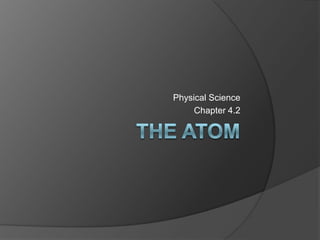Physical science 4.2 : The Atom
•Descargar como PPTX, PDF•
4 recomendaciones•4,393 vistas
Denunciar
Compartir
Denunciar
Compartir

Recomendados
Recomendados
Más contenido relacionado
La actualidad más candente
La actualidad más candente (20)
Distinction of Newton's First law and Galileo's Assertion

Distinction of Newton's First law and Galileo's Assertion
Lesson 3- Synthesis of Elements in the Laboratory.pptx

Lesson 3- Synthesis of Elements in the Laboratory.pptx
DESCRIBE THE GENERAL TYPES OF INTERMOLECULAR FORCES

DESCRIBE THE GENERAL TYPES OF INTERMOLECULAR FORCES
Lesson 2 We Are All Made of Star Stuff (Formation of the Heavy Elements)

Lesson 2 We Are All Made of Star Stuff (Formation of the Heavy Elements)
Destacado
Destacado (20)
Proyecto Pedagógico de Aula: Las TIC y Los Estados De La Materia

Proyecto Pedagógico de Aula: Las TIC y Los Estados De La Materia
ATOMIC ABSORPTION SPECTROSCOPY (AAS) a.k.a SPEKTROSKOPI SERAPAN ATOM (SSA))

ATOMIC ABSORPTION SPECTROSCOPY (AAS) a.k.a SPEKTROSKOPI SERAPAN ATOM (SSA))
Similar a Physical science 4.2 : The Atom
Similar a Physical science 4.2 : The Atom (20)
Más de Chris Foltz
Más de Chris Foltz (20)
Último
God is a creative God Gen 1:1. All that He created was “good”, could also be translated “beautiful”. God created man in His own image Gen 1:27. Maths helps us discover the beauty that God has created in His world and, in turn, create beautiful designs to serve and enrich the lives of others.
Explore beautiful and ugly buildings. Mathematics helps us create beautiful d...

Explore beautiful and ugly buildings. Mathematics helps us create beautiful d...christianmathematics
Making communications land - Are they received and understood as intended? webinar
Thursday 2 May 2024
A joint webinar created by the APM Enabling Change and APM People Interest Networks, this is the third of our three part series on Making Communications Land.
presented by
Ian Cribbes, Director, IMC&T Ltd
@cribbesheet
The link to the write up page and resources of this webinar:
https://www.apm.org.uk/news/making-communications-land-are-they-received-and-understood-as-intended-webinar/
Content description:
How do we ensure that what we have communicated was received and understood as we intended and how do we course correct if it has not.Making communications land - Are they received and understood as intended? we...

Making communications land - Are they received and understood as intended? we...Association for Project Management
Último (20)
Python Notes for mca i year students osmania university.docx

Python Notes for mca i year students osmania university.docx
UGC NET Paper 1 Mathematical Reasoning & Aptitude.pdf

UGC NET Paper 1 Mathematical Reasoning & Aptitude.pdf
Kodo Millet PPT made by Ghanshyam bairwa college of Agriculture kumher bhara...

Kodo Millet PPT made by Ghanshyam bairwa college of Agriculture kumher bhara...
Fostering Friendships - Enhancing Social Bonds in the Classroom

Fostering Friendships - Enhancing Social Bonds in the Classroom
Explore beautiful and ugly buildings. Mathematics helps us create beautiful d...

Explore beautiful and ugly buildings. Mathematics helps us create beautiful d...
Making communications land - Are they received and understood as intended? we...

Making communications land - Are they received and understood as intended? we...
Physical science 4.2 : The Atom
- 1. The Atom Physical Science Chapter 4.2
- 2. Objectives: Describe the size of an atom Namethe parts of an atom Describe the relationship between numbers of protons and neutrons and atomic number State how isotopes differ Calculate atomic masses Describe the forces within an atom Bellringer An atom is the smallest particle into which an element can be divided and still be that element. Now that scientists have learned that an atom is made up of even smaller particles, is this definition still accurate?
- 3. How small is an atom? Three One-Hundred-Millionths of a Centimeter! Scientists know that aluminum is made of average-sized atoms. An aluminum atom has a diameter of about 0.00000003 cm
- 4. What is an atom made of? The Nucleus Protons Positively charged particles in the nucleus Neutrons Particles of the nucleus that have no electrical charge Outside the Nucleus Electrons Negatively charged particles in atoms Found around the nucleus within electron clouds
- 6. How do atoms of different elements differ? Starting Simply The hydrogen atom has one proton and one electron Now for Some Neutrons The helium atom has two protons, two neutrons, and two electrons
- 7. Building Bigger Atoms For bigger atoms simply add protons, neutrons, and electrons Protons and Atomic Number Atomic number The number of protons in the nucleus of an atom All atoms of an element have the same atomic number
- 8. Isotope Atoms that have the same number of protons but have different numbers of neutrons
- 9. Properties of Isotopes An unstable atom is an atom with a nucleus that will change over time Radioactive isotope Telling Isotopes Apart You can identify each isotope of an element by its mass number Mass number Sum of the protons and neutrons in an atom
- 11. Naming Isotopes To identify a specific isotope of an element write the name of the element followed by a hyphen and the mass number of the isotope Carbon-12 6 protons, 6 neutrons Chlorine isotope has 17 protons and 18 neutrons SOchlorine-35, Mass number = protons + neutrons = 17 + 18 = 35 Calculating the Mass of an Element Atomic massof an element weighted average of the masses of all the naturally occurring isotopes of that element
- 13. Forces in the atom Four Basic Forces Four basic forces are at work everywhere even within the atom These forces are: gravitational force electromagnetic force strong force weak force These forces work together to give an atom its structure and properties